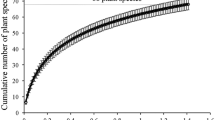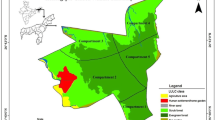Abstract
We systematically collected data on feeding behavior for one group of 33–39 southern muriquis (Brachyteles arachnoides) in Parque Estadual Carlos Botelho (PECB), São Paulo State, Brazil (37,432.45 ha of continuous Atlantic Forest), between January and December 1995. We determined food item consumption from instantaneous scans of behavior. Fruits were the most eaten food items in all 12 mo (40–80% of scan in every mo, average = 71.3%). Muriquis ate young leaves more than mature leaves or flowers. Our results are consistent with previous findings at the same and neighboring forest sites that southern muriquis have a consistently frugivorous diet when inhabiting less disturbed habitats, but contrast with previous observations on oppportunistic frugivory in muriqui populations inhabiting fragmented forests. Sustained high levels of frugivory probably result from year-round availability of fruit within large continuous forests.
Similar content being viewed by others
References
Altmann, J. (1974). “Observational study of behavior: Sampling methods.” Behaviour 49: 227–267.
Brooks, T. M., Mittermeier, R. A., Mittermeier, C. G., da Fonseca, G. A. B., Rylands, A. B., Konstant, W. R., Flick, P., Pilgrim, J., Oldfield, S., Magin, G., and Hilton-Taylor, C. (2002). “Habitat loss and extinction in the hotspots of biodiversity.”Conserv. Biol.16(4): 909–923.
Custódio-Filho, A., Negreiros, O. C., Dias, A. C., and Franco, G. A. D. C. (1992). “Composiçao florística do estrato arbóreo do Parque Estadual de Carlos Botelho, SP.”Segundo Congresso Nacional de Essências Nativas 1: 184–191.
de Carvalho, O. J., Ferrari, S. F., and Strier, K. B. (2004). “Diet of a group of southern muriquis.” Primates 45(3): 201–204.
de Carvalho, O. J. (1996). Dieta, padrões de atividade e de agrupamento do mono-carvoeiro (Brachyteles arachnoides) no Parque Estadual de Carlos Botelho—SP. Masther's Thesis, Dept de Genética. Belém—Pará, Universidade Federal de Belém do Pará.
de Moraes, P. L. R. (1992). “Espécies utilizadas na alimentação do mono-carvoeiro (Brachyteles arachnoides—E GEOFFROY 1806) no Parque Estadual de Carlos Botelho.” Segundo Congresso Nacional de Essências Nativas 1: 1206–1208.
de Moraes, P. L. R., Carvalho Jr, O., and Strier, K. B. (1998). “Population variation in patch and party size in muriquis (Brachyteles arachnoides).” Int. J. Primat. 19(2): 325–337.
Domingues, E. N., and Silva, D. A. (1988). “Geomorfologia do Parque Estadual de Carlos Botelho—SP.” Bol. Tec. Inst. Flor. 42: 7–105.
IUCN, S. (1998). Population and Habitat Viability Assessment (PHVA) for the Muriqui (Brachyteles arachnoides. Belo Horizonte—Brasil.
Lambert, J. E. (1998). “Primate digestion: interactions among anatomy, physiology and feeding ecology.” Evol. Anthr. 7(1): 08–20.
Lee, P. C., Majluf, P., and Gordon, I. J. (1991). “Growth, weaning and maternal investment from a comparative perspective.” J. Zool. Lond. 225: 99–114.
Milton, K. (1981). “Food choice and digestive strategies of two sympatric primate species.” Am. Nat. 117(4): 496–505.
Milton, K. (1984). The role of food-processing factors in primate food choice. In Rodman, P. S., and Cant, J. G. H. (eds.), Adaptations for foraging in Nonhuman primates: Contributions to an organismal biology of prosimians, monkeys and apes. New York, Columbia University Press: pp. 249–279.
Negreiros, O. C., Custodio-Filho, A., Dias, A. C., Franco, G. A. D. C., Couto, H. T. Z., Vieira, M. G. L., and Moura Netto, B. V. (1995). “Analise estrutural de um trecho de floresta pluvial tropical, Parque Estadual de Carlos Botelho, Nucleo de Sete Barras (SP–Brasil).” Bol. Tec. Inst. Flor. 7(1): 1–33.
Oates, J. F. (1977). The Guereza and man. New York, Academic Press.
Pacagnella, S. (1985). Censo de População de Monos-Carvoeiro (Brachyteles arachnoides) no Parque Estadual de Carlos Botelho, Estado de São Paulo. A Primatologia no Brasil 3. Biodiversitas., F. Belo Horizonte, Minas Gerais: 225–234.
Petroni, L. (1993). Aspectos da ecologia e comportamento do mono-carvoeiro (Brachyteles arachnoides—E. Geoffroy, 1806—Cebidae, Primates) na Fazenda Intervales, Serra de Paranapiacaba, São Paulo. Masther's Thesis. Zoologia. Porto Alegre, Pontíficia Universidade Católica do Rio Grande do Sul: 78.
Petroni, L. (2000). Caracterização da área de uso e dieta do mono-carvoeiro (Brachyteles arachnoides, Cebidae-Primates) na Mata Atlantica, Serra de Paranapiacaba, SP. Doctorate Thesis, Departamento de Zoologia. São Paulo—SP, Universidade de São Paulo: 166.
Radambrasil (1983). Projeto Radambrasil: Levantamento de recursos naturais., IBGE - Brasil. Vol. 32.
Richard, A. (Ed). (1985). Primates in nature. New York, W. H. Freeman and Comp.
Rosenberger, A., and Strier, K. (1989). “Adaptive Radiation of the Ateline Primates.” J. Hum. Evol. 18(7): 717–750.
Stevenson, P. R., Quinones, M. J., and Ahumada, J. A. (2000). “Influence of fruit availability on ecological overlap among four neotropical primates at Tinigua National Park, Colombia.” Biotropica 32(3): 533–544.
Strier, K. B. (1986). The behavior and ecology of the woolly spider monkey, or muriqui: (Brachyteles arachnoides, E. Geoffroy 1806). Cambridge, Massachussets, Ph.D. Thesis, Dept. of Anthropology. Harvard University: 352.
Strier, K. B. (1987). “Socioecology of wooly spider monkeys, or muriquis (Brachyteles arachnoides).” Am. J. Phys. Anthrop. 72(2): 259 (000739).
Strier, K. B. (1991). “Diet in One Group of Woolly Spider Monkeys, or Muriquis (Brachyteles arachnoides).” Am. J. Primatol. 23(2): 113–126.
Talebi, M. (2001). Nutritional Factors affecting food choice in wild southern muriquis (Brachyteles arachnoides) in southeastern Brazil. The XVIIIth Congress of the International Primatological Society—Primates in the New Millenium, Adelaide, South Australia, Australia, IPS.
Talebi, M. (2003). “Dietary strategies and digestive efficiency of the southern muriqui (Brachyteles arachnoides).” Am. J. Phys. Anthrop.(Supl. 36): 206.
UNESCO (1999). Convention concerning the protection of the World cultural and natural heritage. Committee, W. H. Marrakech—Morocco, United Nations Educational, Scientific and Cultural Organizations: 118.
Van Roosmalen, M. G. M. (1980). Habitat Preferences, Diet, Feeding Strategy amd Social Organization of the Black Spider Monkey (Ateles paniscus paniscus—Linnaeus 1758) in Surinam, Lanbouwhogeschool (Wageningen): 175.
Author information
Authors and Affiliations
Corresponding author
Rights and permissions
About this article
Cite this article
Talebi, M., Bastos, A. & Lee, P.C. Diet of Southern Muriquis in Continuous Brazilian Atlantic Forest. Int J Primatol 26, 1175–1187 (2005). https://doi.org/10.1007/s10764-005-6463-3
Received:
Revised:
Accepted:
Issue Date:
DOI: https://doi.org/10.1007/s10764-005-6463-3




